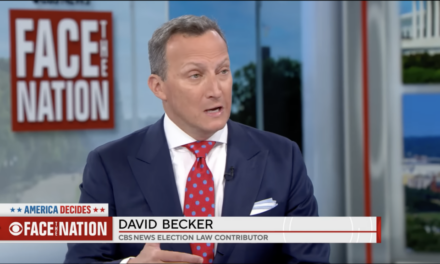We support our Publishers and Content Creators. You can view this story on their website by CLICKING HERE.
At this year’s Human Rights Campaign Dinner, Democrat vice presidential nominee Tim Walz spoke of his and Vice President Kamala Harris’ plan to bring “decency back” to how the country does things. Their plan to bring decency back aims not only to protect human rights and equal justice under the law by ensuring freedom from discrimination for gay and transgender persons, it also includes actively opposing what they believe to be former President Donald Trump’s version of “freedom.”
Trump’s version of freedom, as Walz understands it, is “that that the government should be free to invade ‘every corner of our lives — our bedrooms, our kids’ schools, even our doctor’s office.’” The Republican Party, he says, seeks to remove “reproductive freedoms” from some of the ways people have been choosing to build their families for quite some time already.
Walz further stated that “the bar is pretty damn low … to treat people like human beings.” But considering that Walz is continually advocating for fertility treatments such as in-vitro fertilization (IVF), we have to ask: Where’s the equal justice for those whose lives are diminished to experimental subjects or are simply disposed of through the IVF process? Isn’t the treatment of “extra” human embryonic lives as expendable an affront to the human rights Walz claims to champion?
For his part, former President Donald Trump has recently stated that his administration is “pro-family” and wants more babies to be born; therefore, he wants IVF provided for “free” to infertile couples, either through government subsidization or by mandating that insurance companies pay for it. He appears to remain unconcerned, or at best unaware, that IVF takes more life than it creates.
In either case, perhaps Walz and Trump are simply unaware that in a typical IVF cycle hopeful couples end up with 13 or more lab-created embryos to consider, both practically and morally. Often couples decide what to do with their excess children after they feel their families are “complete.” The sad reality of IVF, though, is that their families are never fully complete while they have frozen children out there waiting to be rescued by their parents. A man and woman with 13 embryos that considers their family “complete” after implanting one more child still have 12 other children who remain, as yet, only partially realized, on ice.
How Clinics Advertise
Before diving into how couples dispose of their “extra” children, let’s examine how clinics market to convince couples to use their services in the first place. Researcher Jim Hawkins sought to provide an in-depth analysis of fertility clinics’ websites to illustrate and better understand how clinics appeal to potential customers. While these websites often appeal to emotions and communicate the types of care they provide, they seldom mention the costs or success rates of services.
As Hawkins found, “some clinics claim to have lower prices but fail to list the price so that consumers can assess the truthfulness of the claim. Along the same lines, one clinic notes the fact that its prices are competitive and that it does not have hidden fees, despite the fact it does not list its fees … [one] clinic charging $9,000 for one IVF cycle, well above the average cost, claims to have ‘the most competitive pricing in the greater Washington area.’ With so little pricing information available, it would be hard for consumers to assess these claims.”
Hawkins found that some clinics will focus solely on emotional content, as, looking at homepages, he found “Of the 372 clinics with websites, 294 … presented images of babies on the Home page of their websites; 112 … used the word ‘dream’ on the Home page; and 33 … used the word ‘miracle.’” He deduced that the reasoning for this includes focusing on a baby as a non-commodity and the relationship between clinic and patient as noncommercial to prevent awareness of cost concerns, since “focusing on dreams … causes patients to underestimate the costs involved in fertility treatments.” Further, this way of marketing can cause couples to associate the images and words with successful pregnancies, making them more likely to act.
In advertising the types of care they provide and the qualifications of their staff, such as excellent technology, large facilities, providing access to donors, working with older patients, and having high-quality doctors, clinics may appear more attractive to patients. For example, “if a clinic’s success rate were lower than its competitors, perhaps the clinic would emphasize other subjective factors like its technological prowess or quality of its doctors to focus patients’ attention on those attributes instead of its lower success rates.”
Once clinics hook clients with the promise of children, they are well on their way to creating an excess of human lives with which to play trial and error without acknowledging the incredible loss of life that accompanies the process.
The Fate of Embryonic Persons
Those embryos who survive preimplantation screenings and are not discarded outright — unneeded leftovers are routinely donated to scientific research, placed within the less than ideal situation of embryo adoption, or indefinitely frozen until their parents decide what to do with them. These frozen embryos may be included as “property” in wills and divorce proceedings, but more often than not they undergo one of the aforementioned unfortunate fates:
“In the end we discarded, which is the option we didn’t want and I still feel pangs about it. But with many parenting decisions you do what you feel is right at the time and have to accept that you may have regrets later.”
“Personally, I’d do research, but that’s not allowed in my country, so we had them destroyed.”
“I put my Embryos in research, maybe some day this will be an affordable option, and have a greater than a 10 % chance of a successful pregnancy.”
“We have leftover embryos and will be discarding what we don’t use (or donating to science…). I’m not comfortable with other people raising children that are genetically mine.”
“If this second pregnancy takes like the first one then there will be 5 left. I think I would wait a few years to make certain I do not want anymore kids then I think I would donate to science or discard.”
“The doctor we talked to said in our area there wasn’t a lot of unmet demand for embryos for research… so we decided that we would be ok discarding them, once we completed our family.”
“Research or discard. They aren’t babies and I am not up for complicated mixed family dynamics and I don’t trust anyone else to treat my children well.”
“We have 6 embryos in storage right now… I’m firmly in the destroy or science (preferred) category.”
“I would donate to science under the stipulation that they would never be used for pregnancy, or destroy them. I could never adopt out my own kid like that.”
“We had 9 left over after we conceived our son. I never wanted them thrown away so they are now scientists. That’s how I think of them. They’re contributing to science and I am incredibly proud of all of them.”
“We are donating our embryos to science… I used donor eggs, so it’s not my dna … we are going to have quite a few left over. We currently have 15 embryos and two kids … science was the best option for us. If it was my own, I’d do the same. I wouldn’t be comfortable with adopting out embryos for many reasons.”
The insufficiency of the “adoption” option provides insight into the moral qualms that come with IVF, as many parents, such as those just quoted, and particularly mothers, acknowledge that these “extra” embryos are human beings when it comes to giving them away to other people.
They know in the deepest places of their hearts that children are not commodities to be discarded, bought or sold, or given away like chattel, consigned to cold, suspended animation, or killed through science (no matter how “cute” the delusion of calling these destroyed children “little scientists” might sound).
Before we can have the true “freedom” that Harris and Walz envision, we must stop fooling infertile couples with false hope through marketing meant to enchant them into deadly decisions, and rather provide equal justice for all persons, including the smallest among us.
Katie Breckenridge works for the children’s rights organization Them Before Us and is the author of the book Silent Sorrows: Let’s talk about abortion, reproductive technologies, and adoption.

 Conservative
Conservative  Search
Search Trending
Trending Current News
Current News 





